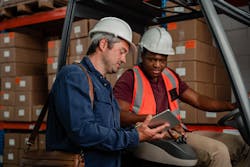The Digital Age is Here. Is Your Workforce Prepared?
What was to come is, in fact, already here. Analyzing data based on a myriad of software platforms is how most companies operate today. And that data has moved out of the IT department and is now available across the company.
My favorite example of this new world is the commercial where a football player uses analytics after his touchdown to review the percentage possibilities of what he accomplished. If football players can become so comfortable with this, then your employees can as well.
This isn’t a situation where it would be nice if everyone had these skills—it’s more dire than that, according to the G20 network, an international forum of governments and banks. In a recent report, the group warned that people over age 35 must develop the agility to diversify their knowledge base and embrace data analysis if “we are to ensure no one is left behind.”
Luckily, we have the technology—artificial intelligence (AI)—to create that knowledge base. And this technology can be used by workers at all levels, from those on the factory floor to those in more corporate functions.
“All people are skilled but are simply not presented with the right information and technology to apply those skills,” says Gabe Batstone, CEO of Contextere, an industrial software company.
Batstone founded his company to bring data culled from AI directly to the workers on the line. As he explains it, “Warm hands still touch cold steel, [but] the information on how to be safe and productive is just not reaching these workers. These workers have been left behind when it comes to using the data we are collecting, and these are the people who are making our trains run and our planes fly.”
Batstone points out that big data and AI can contextualize the information, making it consumable for everyone. By using wearables, data provided through AI as well as other technologies such as the Internet of Things, machine learning and augmented reality can be used to increase safety in a facility. In fact, the G20’s Think20 task force has recommended AI-based learning to better prepare workers throughout the world.
So how can we ensure that current and future workers learn how to use these technologies? While the most common answer used to be through a four- or two-year degree program, it turns out that is not the only option. A new system has emerged called microlearning, which involves the issuing of micro-credentials. These credentials demonstrate that someone has mastered a very specific skill, for which they receive a badge. The earliest badges were awarded for computer programming, so it’s a next logical step to use this system for AI.
Using new educational techniques is something companies have been exploring for quite a few years. In 2016, for instance, IBM’s then-CEO Ginni Rometty let it be known that many of the jobs at IBM don’t require a college-degree but specific training. She pointed out that as many as one-third of IBM employees did not have four-year degrees, in such areas as cybersecurity, data science and cognitive business.
Rometty rightly recognized that it’s the skill set, not a preset education level, that is necessary for companies to fill the jobs IBM had open and will need in the future.
While many businesses are both looking for talent with a variety of education acumen and providing in-house training, it will also be interesting to see the role that government might take. G20 has offered recommendations that it suggests governments take to utilize AI-based learning, including:
- Embracing and regulating industry micro-credentials;
- Accessing government funding for workplace learning in traditional sectors and those working within the platform and gig economies; and
- Promoting innovative technical and vocational education training institutions with the backing of quality control and licensing bodies.
As Heidi Alaskary, co-chair of Think20, says, “It is now the responsibility of governments, industries and citizens to collaborate to humanize the technological process and bring balance to the future way of working,” and by extension, creating safer workplaces for all of us.
About the Author
Adrienne Selko
Senior Editor
Email [email protected]
Adrienne Selko is also the senior editor at Material Handling and Logistics and is a former editor of IndustryWeek.

